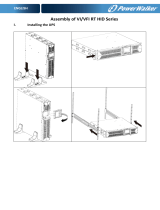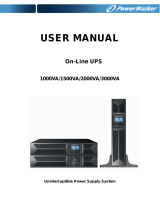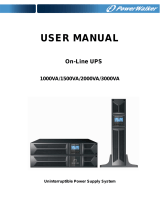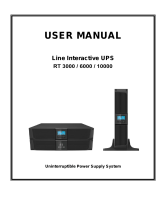
Page 4
5-6kVA EU_EN
Safety of persons
The system has its own power source (the battery). Consequently, the power outlets may be energized p
even if the systems is disconnected from the AC power source. Dangerous voltage levels are present
within the system. It should be opened exclusively by qualied service personnel.
The system must be properly grounded. p
The battery supplied with the system contains small amounts of toxic materials. p
To avoid accidents, the directives listed below must be observed:
- servicing of batteries should be performed or supervised by personnel knowledgeable about batteries
and the required precautions.
- when replacing batteries, replace with the same type and number of batteries or battery packs.
- do not dispose of batteries in a re. The batteries may explode.
- batteries constitute a danger (electrical shock, burns). The short-circuit current may be very high.
Precautions must be taken for all handling:
Wear rubber gloves and boots. p
Do not lay tools or metal parts on top of batteries. p
Disconnect charging source prior to connecting or disconnecting battery terminals. p
Determine if battery is inadvertently grounded. If inadvertently grounded, remove source from ground. p
Contact with any part of a grounded battery can result in electrical shock. The likelihood of such shock
can be reduced if such grounds are removed during installation and maintenance (applicable to
equipment and remote battery supplies not having a grounded supply circuit).
Product safety
The UPS connection instructions and operation described in the manual must be followed in p
the indicated order.
CAUTION - To reduce the risk of re, the unit connects only to a circuit provided with branch circuit p
overcurrent protection for : 30A rating, for 5-6kVA models in accordance with the National Electric Code,
ANSI/NFPA 70 (US installations only).
The upstream circuit breaker must be easily accessible.
The unit can be disconnected from AC power source by opening this circuit breaker.
Disconnection and overcurrent protection devices shall be provided by others for permanently p
connected AC input/output circuits.
Check that the indications on the rating plate correspond to your AC powered system and p
to the actual electrical consumption of all the equipment to be connected to the system.
For PLUGGABLE EQUIPMENT, the socket-outlet shall be installed near the equipment and shall p
be easily accessible
Never install the system near liquids or in an excessively damp environment. p
Never let a foreign body penetrate inside the system. p
Never block the ventilation grates of the system. p
Never expose the system to direct sunlight or source of heat. p
If the system must be stored prior to installation, storage must be in a dry place. p
The admissible storage temperature range is -15ºC to +50ºC. p
The system is not for use in a computer room AS DEFINED IN the standard for the Protection p
of Information Technology Equipment, ANSI/NFPA 75 (US installations only).
Contact Eaton resellers to order a special battery kit if needed to meet the NE code requirement.
Special precautions
All handling operations will require at least two people (unpacking, installation in rack system). p
Before and after the installation, if the UPS remains de-energized for a long period, the UPS must be p
energized for a period of 24 hours, at least once every 6 months (for a normal storage temperature
less than 25°C). This charges the battery, thus avoiding possible irreversible damage.
During the replacement of the Battery Module, it is imperative to use the same type and number of p
element as the original Battery Module provided with the UPS to maintain an identical level of
performance and safety. In case of doubt, don’t hesitate to contact your EATON representative.
All repairs and service should be performed by AUTHORIZED SERVICE PERSONNEL ONLY. p
There are NO USER SERVICEABLE PARTS inside the UPS.
SAFETY INSTRUCTIONS
























